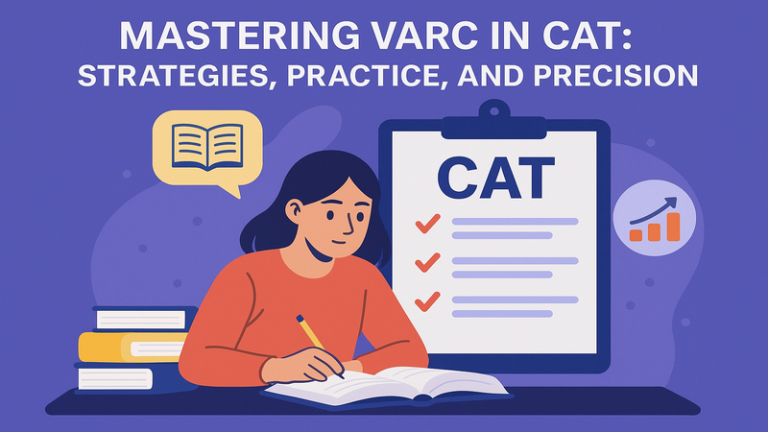Quantitative Aptitude is the key to CAT success. Learn how to master QA with topic-wise study plans, common mistake analysis, time management strategies, and advanced problem-solving techniques. Build accuracy, speed, and confidence for CAT 2025.
Quantitative Aptitude in CAT: Mastering the Numbers Game

Quantitative Aptitude (QA) is perhaps the most intimidating section for many CAT aspirants. Unlike VARC, which depends on reading comprehension, or DILR, which tests reasoning and adaptability, Quantitative Aptitude(QA) measures conceptual clarity, speed of calculation, and problem-solving ability. It is not only about knowing mathematical formulas but also about applying them quickly and accurately under time pressure. A strong performance in Quantitative Aptitude(QA) can elevate the overall percentile significantly, especially since sectional cut-offs are crucial for IIM calls.
This article provides an in-depth approach to conquering Quantitative Aptitude(QA) by breaking down the syllabus, designing a study plan, discussing common mistakes, and outlining strategies for both beginners and advanced aspirants.
Understanding the Quantitative Aptitude(QA) Section
The Quantitative Aptitude(QA) section of CAT consists of 22 questions to be solved in 40 minutes. These questions are derived from high school-level mathematics, but they are structured in a way that tests logical application more than rote learning. Questions are multiple-choice (MCQ) as well as non-MCQ (TITA: Type In The Answer), where no options are provided.
MBA Entrance Exams 2025-26
The section typically covers:
- Arithmetic: Percentages, Profit and Loss, Averages, Ratio and Proportion, Time-Speed-Distance, Time and Work.
- Algebra: Linear and Quadratic Equations, Inequalities, Progressions, Functions, Logarithms.
- Geometry and Mensuration: Triangles, Circles, Polygons, Coordinate Geometry, Mensuration formulas.
- Numbers: Divisibility, HCF, LCM, Factorials, Remainders.
- Modern Math: Permutations and Combinations, Probability, Set Theory.
Arithmetic and Algebra usually dominate the section, accounting for nearly half the paper. Geometry and Numbers also appear consistently. Modern Math appears less frequently but should not be ignored.
Building the Foundation
Aspirants must begin Quantitative Aptitude(QA) preparation by strengthening the basics. The key is to understand concepts rather than memorizing shortcuts. For example, in Time-Speed-Distance, it is not enough to memorize formulas like Speed = Distance / Time; one must also learn to apply ratios, relative speed, and average speed concepts across different scenarios.
A formula sheet should be maintained from the very beginning. Over time, this sheet becomes a go-to revision resource, especially in the last few weeks before the exam.
Step-by-Step Strategy
1. Learn the Basics
Spend the first 4–6 weeks revising school-level math concepts. Use books such as Quantitative Aptitude for CAT by Arun Sharma or coaching material from TIME, IMS, or Career Launcher.
2. Practice Sectionally
Divide your preparation into modules. For example, dedicate one week entirely to Arithmetic, the next to Algebra, and so on. After completing each module, solve topic-specific questions under time constraints.
3. Mix Easy and Difficult Questions
CAT is notorious for mixing straightforward questions with tricky ones. Practice a variety of problems so that you do not panic when faced with unfamiliar formats.
4. Use Mock Tests Wisely
Start taking sectional Quantitative Aptitude(QA) tests after 2–3 months of preparation. Full-length mocks should be introduced gradually, with deep analysis after every attempt.
Apply Now for MBA^/PGDM
Common Mistakes in Quantitative Aptitude(QA)
One of the most common mistakes aspirants make is attempting questions sequentially. Since the CAT exam does not require attempting all questions, it is wiser to pick questions strategically. Spending five minutes on a single problem may cause you to miss out on two easier ones later.
Another frequent error is over-reliance on shortcuts. While Vedic mathematics and approximations are useful, they are not a substitute for conceptual understanding. Similarly, aspirants often neglect topics they find difficult, such as Geometry or Probability, only to face an exam filled with those very questions.
Time Management
Time management in QA is about a balance between speed and accuracy. Aspirants should not aim to solve all 22 questions. Instead, the goal should be to solve 14–16 questions with high accuracy, which is usually enough for a 99+ percentile.
A suggested approach:
- Spend the first 2–3 minutes scanning the section, marking easy and doable questions.
- Attempt high-confidence questions first, ensuring accuracy.
- Come back to moderately difficult ones if time permits.
- Avoid spending more than 2 minutes on a single problem.
Daily Study Routine
For effective Quantitative Aptitude(QA) preparation, a structured daily plan is essential:
- 30 minutes: Revise formulas and key concepts.
- 60 minutes: Solve 20–25 questions from one topic.
- 30 minutes: Mixed practice (easy, medium, and difficult problems).
- 10 minutes: Review errors and note down learnings.
Advanced Tips for Quantitative Aptitude(QA)
- Develop Number Sense: Be comfortable with approximations, fractions, percentages, and ratios. This improves calculation speed significantly.
- Practice Mental Math: Reduce dependence on pen and paper for small calculations.
- Work on Weak Areas: If Geometry is weak, dedicate a full week to it instead of avoiding it.
- Simulate Exam Pressure: Practice solving 10 questions in 20 minutes regularly to build speed.
Psychological Preparation
Many aspirants panic in Quantitative Aptitude(QA) due to math phobia. Overcoming this requires consistent exposure and gradual confidence-building. Start with easy problems, enjoy small victories, and then move to higher-difficulty questions. Remember, CAT Quantitative Aptitude(QA) is not about being a mathematician—it is about being a smart problem solver under time constraints.
Frequently Asked Questions (FAQ)
Q1. How many questions should I attempt in Quantitative Aptitude(QA) for 99 percentile?
On average, attempting 14–16 questions accurately out of 22 is sufficient for 99 percentile.
Q2. Is Arithmetic more important than other topics?
Yes, Arithmetic forms the foundation and carries high weightage. However, Algebra and Geometry also play significant roles, so balance is necessary.
Group Discussion Topics
Q3. Should I focus more on speed or accuracy?
Accuracy is more important. A candidate with fewer but correct attempts scores higher than one with more but error-prone attempts.
Q4. What resources are best for Quantitative Aptitude(QA) practice?
Books by Arun Sharma, past CAT papers, and sectional mocks from coaching institutes are excellent resources.
Q5. Can a non-math student crack Quantitative Aptitude(QA)?
Absolutely. Many toppers from humanities and commerce backgrounds have excelled in Quantitative Aptitude(QA) by focusing on basics, practicing regularly, and building confidence gradually.














